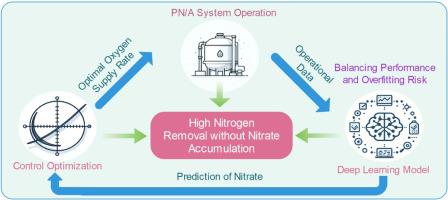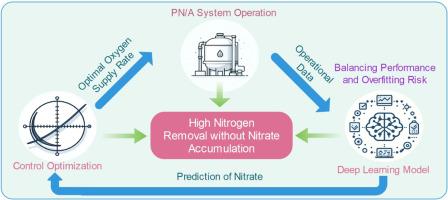Small-data-trained model for predicting nitrate accumulation in one-stage partial nitritation-anammox processes controlled by oxygen supply rate
IF 11.4
1区 环境科学与生态学
Q1 ENGINEERING, ENVIRONMENTAL
引用次数: 0
Abstract
Nitrate (NO3−-N) accumulation is the biggest obstacle for wastewater treatment via partial nitritation-anammox process. Dissolved oxygen (DO) control is the most used strategy to prevent NO3−-N accumulation, but the performance is usually unstable. This study proposes a novel strategy for controlling NO3−-N accumulation based on oxygen supply rate (OSR). In comparison, limiting the OSR is more effective than limiting DO in controlling NO3−-N accumulation through mathematical simulation. A laboratory-scale one-stage partial nitritation-anammox system was continuously operated for 135 days, which was divided into five stages with different OSRs. A novel deep learning model integrating Gated Recurrent Unit and Multilayer Perceptron was developed to predict NO3−-N accumulation load. To tackle with the general obstacle of limited environmental samples, a generic evaluation was proposed to optimise the model structure by leveraging predictive performance and overfitting risk. The developed model successfully predicted the NO3−-N accumulation in the system ten days in advance, showcasing its potential contribution to system design and performance enhancement.


用于预测受供氧速率控制的单级部分亚硝酸盐-anammox过程中硝酸盐累积的小数据训练模型
硝酸盐(NO3--N)积累是通过部分亚硝酸盐化-anammox工艺处理废水的最大障碍。溶解氧(DO)控制是防止 NO3-N 积累最常用的策略,但其效果通常不稳定。本研究提出了一种基于供氧量(OSR)的控制 NO3-N 积累的新策略。通过数学模拟比较,限制供氧率比限制溶解氧更能有效控制 NO3-N 的积累。一个实验室规模的单级部分亚硝酸盐化-anammox系统连续运行了135天,分为五个阶段,具有不同的OSR。建立了一个集成了门控递归单元和多层感知器的新型深度学习模型,用于预测NO3--N累积负荷。针对环境样本有限这一普遍障碍,提出了一种通用评估方法,利用预测性能和过拟合风险优化模型结构。所开发的模型成功预测了系统中十天的 NO3-N 累积量,展示了其对系统设计和性能提升的潜在贡献。
本文章由计算机程序翻译,如有差异,请以英文原文为准。
求助全文
约1分钟内获得全文
求助全文
来源期刊

Water Research
环境科学-工程:环境
CiteScore
20.80
自引率
9.40%
发文量
1307
审稿时长
38 days
期刊介绍:
Water Research, along with its open access companion journal Water Research X, serves as a platform for publishing original research papers covering various aspects of the science and technology related to the anthropogenic water cycle, water quality, and its management worldwide. The audience targeted by the journal comprises biologists, chemical engineers, chemists, civil engineers, environmental engineers, limnologists, and microbiologists. The scope of the journal include:
•Treatment processes for water and wastewaters (municipal, agricultural, industrial, and on-site treatment), including resource recovery and residuals management;
•Urban hydrology including sewer systems, stormwater management, and green infrastructure;
•Drinking water treatment and distribution;
•Potable and non-potable water reuse;
•Sanitation, public health, and risk assessment;
•Anaerobic digestion, solid and hazardous waste management, including source characterization and the effects and control of leachates and gaseous emissions;
•Contaminants (chemical, microbial, anthropogenic particles such as nanoparticles or microplastics) and related water quality sensing, monitoring, fate, and assessment;
•Anthropogenic impacts on inland, tidal, coastal and urban waters, focusing on surface and ground waters, and point and non-point sources of pollution;
•Environmental restoration, linked to surface water, groundwater and groundwater remediation;
•Analysis of the interfaces between sediments and water, and between water and atmosphere, focusing specifically on anthropogenic impacts;
•Mathematical modelling, systems analysis, machine learning, and beneficial use of big data related to the anthropogenic water cycle;
•Socio-economic, policy, and regulations studies.
 求助内容:
求助内容: 应助结果提醒方式:
应助结果提醒方式:


